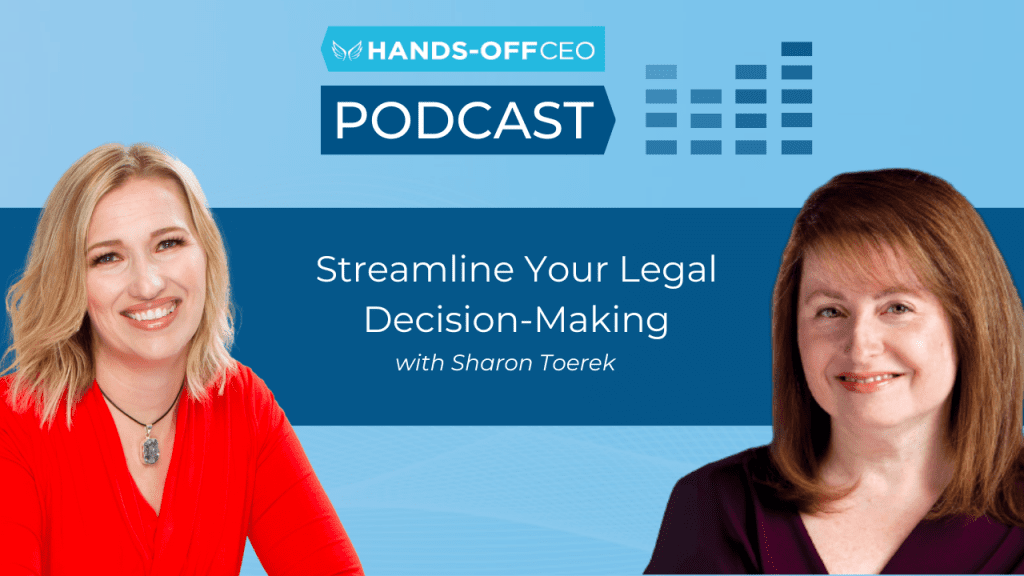
Streamline Your Legal Decision-Making with Sharon Toerek – E98
In this week’s episode of Hands-Off CEO, Sharon Toerek discusses how to streamline legal decision-making in your business. She joins me to share insights on setting up systems for making informed legal choices, and delve into the importance of master service agreements and key components of a legal service agreement. You will also learn practical tips specifically for agencies and gain a deeper understanding of how to separate CEO involvement in day-to-day operations.
Sharon Toerek is a marketing law and IP lawyer serving agencies through her company Legal + Creative | Toerek Law. She is also the host of the Innovative Agency Podcast. She is a former President of AAF Cleveland and serves on the American Association of Advertising Agencies (4A) Legal Consultant panel. With expertise in IP protection, marketing agency relationships and social media laws, Sharon writes and lectures on these topics in the advertising industry.
Key Ideas:
- “We spend a lot of time helping agencies understand and plan for the fact that the intellectual property they create is not only a bargaining chip in the agency client contract negotiation, but you’re also creating assets for yourself,” Sharon tells me. Agencies need to protect their intellectual property as assets for future monetization and efficiency. [4:50]
- The biggest mistake in contract negotiation is not treating it as part of the client experience and not planning for it. Focusing on the “3 Ds” (dollars, deliverables, deadlines) is easy, but you can miss important details in the Master Service Agreement. Contracting with clients requires thoughtfulness; it can be streamlined with good upfront process and systems. [5:42]
- Essential elements to be included in Master Service Agreement:
- Term and termination
- Intellectual property language, IP ownership and transfer, ensuring work rights are assigned only after payment
- Reserving IP right for agency, carve out of IP language and proprietary information
- Liability and indemnification, capping party’s liability based on revenue
- Exclusivity and restrictive covenants, non-solicitation of each other’s talent [10:25]
- I remark that agencies struggle to use case studies as they are not allowed to share the results of their work with clients. This creates a lack of feedback loop which is crucial in improving their work. As such, she believes that you should not even consider working with clients who won’t allow your agency to use their case studies as reference. [14:21]
- As agencies grow, they will need to rely on freelancers, contractors, and partners to service their clients. This requires having well-drafted agreements in place to solidify these relationships and protect all parties. Agencies should be systematic about training their team on their legal infrastructure and Master Service Agreement to avoid conflicts with clients. [17:45]
- Sharon mentions that three key factors to maximizing profit are: pricing correctly, payment terms, and time from start to finish. [23:40]
- One major costly legal issue in creative businesses is not having sound practices in place; for example, due diligence in the creative process like clearing trademarks, copyright issues. This can result in missed opportunity and business interruption, interruption of cash flow, and even having to redo work. [28:31]
- The agency should still pursue payment for work done, unless the work is unacceptable to the client or the agency did not fulfill its end of the obligation. Try intermediate steps and escalation before involving the legal department. I add that you should negotiate in a human way to maintain the relationship and retain referral opportunities. In the end, legal recourse often leads to an ego battle and a loss-lose situation. [35:11]
KEY QUOTE:
“It’s inevitable that your business is going to expand more quickly than your internal team does. So, inevitably, you’re going to need freelancers, contractors, strategic partners to help you service particular projects or clients. You need to be thinking about the documents and agreements that will solidify those relationships and protect all the parties, not only because you want to protect the agency, but because if you’ve made a promise to the client in your contract with them, it really needs to be reflected in your agreement with these other parties.” – Sharon Toerek
Resources
Sharon Toerek on LinkedIn | Twitter | Email






